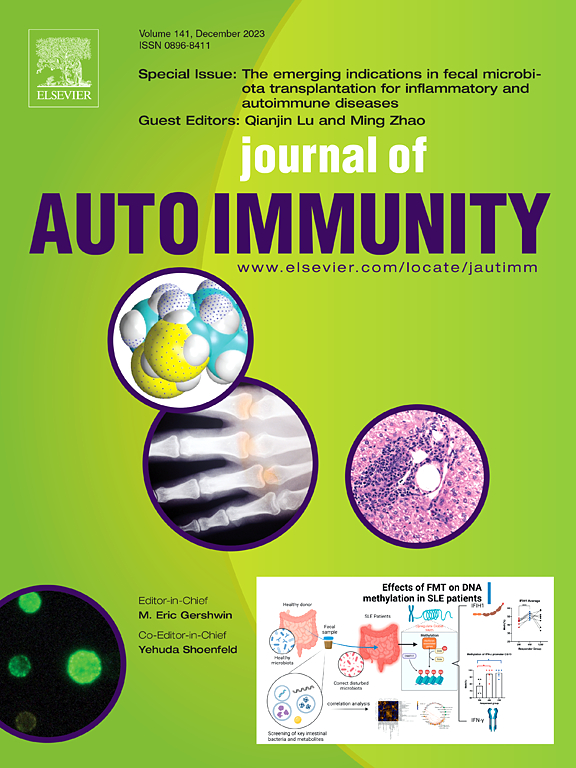Familial patterns of alopecia areata: A systematic review and meta-analysis
IF 7
1区 医学
Q1 IMMUNOLOGY
引用次数: 0
Abstract
Background
Alopecia Areata (AA) is a T cell-mediated autoimmune disease characterized by sudden hair loss. It is associated with a significant familial predisposition and comorbidities such as thyroid disease, diabetes, atopic dermatitis, and vitiligo. This study aims to systematically review and meta-analyze the prevalence of familial AA and its associated comorbidities to better understand the hereditary nature of the disease.
Methods
A systematic review and meta-analysis were conducted following the PRISMA guidelines. Relevant studies were identified from databases including EMBASE, Cochrane Library, PubMed, and Web of Science up to October 15, 2023. Studies were included if they reported on AA patients with a confirmed diagnosis and a family history of AA or related comorbidities. Data extraction and quality assessment were performed by two independent reviewers, with discrepancies resolved by a third reviewer. Pooled prevalence estimates were calculated using a random effects model.
Results
The meta-analysis included 67 studies, encompassing 24,226 AA patients and their relatives. The prevalence of a family history of alopecia areata (AA) was found to be 17.6 %, indicating that 17.6 % of individuals with AA have a positive family history of the condition. (CI: 14.9 %–20.6 %, I2 = 96 %). The prevalence among relatives was 0.90 % (CI: 0.55 %–1.47 %, I2 = 98 %), with the highest prevalence observed in first-degree relatives at 3.22 % (CI: 2.31 %–4.48 %, I2 = 94 %). Comorbid conditions were present in 9.61 % (CI: 6.98 %–13.1 %, I2 = 95 %) of family members across first-, second-, and third-degree relatives of individuals with alopecia areata have comorbid autoimmune or related conditions, including thyroid disease (4.7 %), diabetes (10.1 %), atopic dermatitis (18.9 %), vitiligo (5.5 %), and other autoimmune disease (12.1 %).
Conclusion
This systematic review and meta-analysis highlight the significant familial risk and comorbidities in family members of AA patients. The findings emphasize the need for comprehensive family monitoring, which includes regular health screenings for autoimmune and related conditions among relatives of AA patients, and genetic counseling to educate families on hereditary risks and to guide early intervention and monitoring strategies. It can lead to improved outcomes. In the future, large population-based studies focusing on second and third-degree relatives are needed to further elucidate these associations.
斑秃的家族性模式:系统回顾和荟萃分析
斑秃(AA)是一种以突发性脱发为特征的T细胞介导的自身免疫性疾病。它与显著的家族易感性和合并症有关,如甲状腺疾病、糖尿病、特应性皮炎和白癜风。本研究旨在系统回顾和荟萃分析家族性AA的患病率及其相关合并症,以更好地了解该疾病的遗传性。方法按照PRISMA指南进行系统评价和荟萃分析。截至2023年10月15日,相关研究从EMBASE、Cochrane Library、PubMed和Web of Science等数据库中确定。如果研究报告的AA患者确诊并有AA家族史或相关合并症,则纳入研究。数据提取和质量评估由两名独立审查员进行,差异由第三名审查员解决。使用随机效应模型计算合并患病率估计值。结果meta分析纳入67项研究,包括24226例AA患者及其亲属。斑秃家族史的患病率为17.6%,表明17.6%的斑秃患者有斑秃家族史。(ci: 14.9% - 20.6%, i2 = 96%)。亲属患病率为0.90% (CI: 0.55% ~ 1.47%, I2 = 98%),一级亲属患病率最高,为3.22% (CI: 2.31% ~ 4.48%, I2 = 94%)。9.61% (CI: 6.98% - 13.1%, I2 = 95%)斑秃患者的一、二、三度亲属有自身免疫性或相关疾病共病,包括甲状腺疾病(4.7%)、糖尿病(10.1%)、特应性皮炎(18.9%)、白癜风(5.5%)和其他自身免疫性疾病(12.1%)。结论本系统综述和荟萃分析强调了AA患者家庭成员存在显著的家族性风险和合并症。研究结果强调了全面的家庭监测的必要性,包括定期对AA患者亲属进行自身免疫和相关疾病的健康检查,以及遗传咨询,以教育家庭了解遗传风险,并指导早期干预和监测策略。它可以带来更好的结果。在未来,需要针对二度和三度亲属的大规模人群研究来进一步阐明这些关联。
本文章由计算机程序翻译,如有差异,请以英文原文为准。
求助全文
约1分钟内获得全文
求助全文
来源期刊

Journal of autoimmunity
医学-免疫学
CiteScore
27.90
自引率
1.60%
发文量
117
审稿时长
17 days
期刊介绍:
The Journal of Autoimmunity serves as the primary publication for research on various facets of autoimmunity. These include topics such as the mechanism of self-recognition, regulation of autoimmune responses, experimental autoimmune diseases, diagnostic tests for autoantibodies, as well as the epidemiology, pathophysiology, and treatment of autoimmune diseases. While the journal covers a wide range of subjects, it emphasizes papers exploring the genetic, molecular biology, and cellular aspects of the field.
The Journal of Translational Autoimmunity, on the other hand, is a subsidiary journal of the Journal of Autoimmunity. It focuses specifically on translating scientific discoveries in autoimmunity into clinical applications and practical solutions. By highlighting research that bridges the gap between basic science and clinical practice, the Journal of Translational Autoimmunity aims to advance the understanding and treatment of autoimmune diseases.
 求助内容:
求助内容: 应助结果提醒方式:
应助结果提醒方式:


